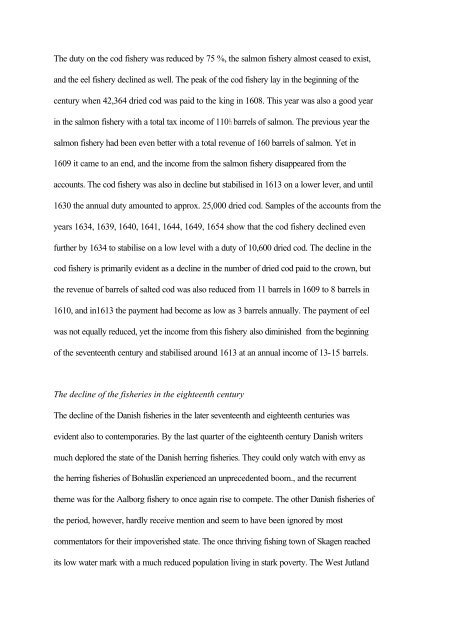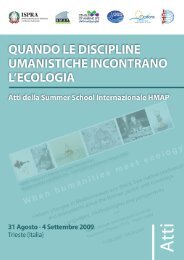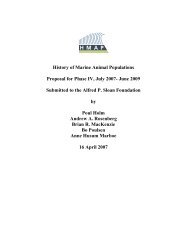The Danish fisheries c.1450-1800. Medieval and early modern ...
The Danish fisheries c.1450-1800. Medieval and early modern ...
The Danish fisheries c.1450-1800. Medieval and early modern ...
You also want an ePaper? Increase the reach of your titles
YUMPU automatically turns print PDFs into web optimized ePapers that Google loves.
<strong>The</strong> duty on the cod fishery was reduced by 75 %, the salmon fishery almost ceased to exist,<br />
<strong>and</strong> the eel fishery declined as well. <strong>The</strong> peak of the cod fishery lay in the beginning of the<br />
century when 42,364 dried cod was paid to the king in 1608. This year was also a good year<br />
in the salmon fishery with a total tax income of 110½ barrels of salmon. <strong>The</strong> previous year the<br />
salmon fishery had been even better with a total revenue of 160 barrels of salmon. Yet in<br />
1609 it came to an end, <strong>and</strong> the income from the salmon fishery disappeared from the<br />
accounts. <strong>The</strong> cod fishery was also in decline but stabilised in 1613 on a lower lever, <strong>and</strong> until<br />
1630 the annual duty amounted to approx. 25,000 dried cod. Samples of the accounts from the<br />
years 1634, 1639, 1640, 1641, 1644, 1649, 1654 show that the cod fishery declined even<br />
further by 1634 to stabilise on a low level with a duty of 10,600 dried cod. <strong>The</strong> decline in the<br />
cod fishery is primarily evident as a decline in the number of dried cod paid to the crown, but<br />
the revenue of barrels of salted cod was also reduced from 11 barrels in 1609 to 8 barrels in<br />
1610, <strong>and</strong> in1613 the payment had become as low as 3 barrels annually. <strong>The</strong> payment of eel<br />
was not equally reduced, yet the income from this fishery also diminished from the beginning<br />
of the seventeenth century <strong>and</strong> stabilised around 1613 at an annual income of 13-15 barrels.<br />
<strong>The</strong> decline of the <strong>fisheries</strong> in the eighteenth century<br />
<strong>The</strong> decline of the <strong>Danish</strong> <strong>fisheries</strong> in the later seventeenth <strong>and</strong> eighteenth centuries was<br />
evident also to contemporaries. By the last quarter of the eighteenth century <strong>Danish</strong> writers<br />
much deplored the state of the <strong>Danish</strong> herring <strong>fisheries</strong>. <strong>The</strong>y could only watch with envy as<br />
the herring <strong>fisheries</strong> of Bohuslän experienced an unprecedented boom., <strong>and</strong> the recurrent<br />
theme was for the Aalborg fishery to once again rise to compete. <strong>The</strong> other <strong>Danish</strong> <strong>fisheries</strong> of<br />
the period, however, hardly receive mention <strong>and</strong> seem to have been ignored by most<br />
commentators for their impoverished state. <strong>The</strong> once thriving fishing town of Skagen reached<br />
its low water mark with a much reduced population living in stark poverty. <strong>The</strong> West Jutl<strong>and</strong>






